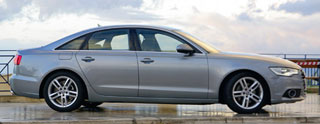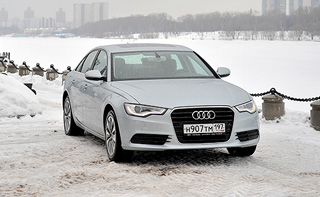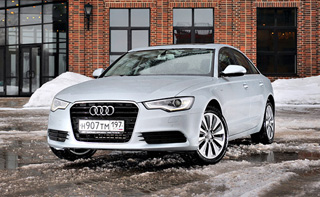Audi A6 test drive since 2011 sedan
The third force
 Two polar forces can conduct an endless struggle for power. Until a third one comes and puts a fat point in it, capturing leadership. He has already come. His name is multitronic.
Two polar forces can conduct an endless struggle for power. Until a third one comes and puts a fat point in it, capturing leadership. He has already come. His name is multitronic. Does the Audi A6 need a special performance? Of course, no, you say, and you will be right. But only partly. Because the model, the presentation of which took place in October of this year, is, in fact, a fundamentally new machine.
Outwardly, everything remained as before, neither the engine nor the suspension changed. The novelty was concentrated in the unit only called Multitronic. It is a third-generation transmission of an automatic, unacceptable variator (CVT) with electron-software control. He has so changed the nature and consumer qualities of the car that it can be called new without exaggeration.
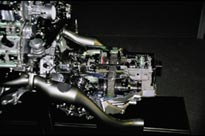 Vertical movement. The essence of the CVT (Continiously Variable thanSmission) briefly is as follows: the transmission of the torque from the engine to the wheels is carried out by means of two pulleys of variable width with the conical inner surface, interconnected by a wedge -shaped belt. One of these pulleys is the leading, the other driven. Each pulley consists of two halves that can shift or part, thereby changing the diameter of the circle along which the belt moves. Due to this, a constant smooth change in gear force is ensured depending on the torque and engine speed. Theoretically, this design makes the number of variants of gear ratio equal to infinity. And this means that the engine is constantly operating in the most optimal mode, its capabilities are used with maximum return
Vertical movement. The essence of the CVT (Continiously Variable thanSmission) briefly is as follows: the transmission of the torque from the engine to the wheels is carried out by means of two pulleys of variable width with the conical inner surface, interconnected by a wedge -shaped belt. One of these pulleys is the leading, the other driven. Each pulley consists of two halves that can shift or part, thereby changing the diameter of the circle along which the belt moves. Due to this, a constant smooth change in gear force is ensured depending on the torque and engine speed. Theoretically, this design makes the number of variants of gear ratio equal to infinity. And this means that the engine is constantly operating in the most optimal mode, its capabilities are used with maximum return The name of the belt in modern CVT is very conditional, since it is a multilayer steel tape with steel plates strung on it. One of the features of the Audi Multitronic design is the use of a multi -zero chain instead of such a belt. It consists of more than a thousand plates, interconnected by seven -year -old five -pairs of axes. Unlike traditional ones, such a belt is more compact, flexible and capable of transmitting a higher torque. The probability of longitudinal slippage of the chain is significantly reduced, which positively affected the dynamic characteristics of the car.
Variator pulleys simultaneously perform two main functions: they hold the chain in a certain position and change the transfer numbers, moving it in the vertical direction. In the existing CVT, one hydraulic cylinder is in charge of this. Audi went further and divided these functions between the two cylinders, adding a special torque sensor. The main achievement was a more dynamic and operational change in transmission numbers, which, in turn, did not slow down to affect the reaction of the car to gas.
Another fundamental difference between multitronic: the connection with the engine is not carried out through a hydrotransformer, as usual, but through a multi -disc clutch, separate for moving forward and reverse. Its advantages are that with a sharp pressing to the gas transmission more quickly, this clutch also allows more accurately dose the moment, for example, when moving on slippery surfaces.
The self -learning electronic control unit commands all this, the design and principle of which are borrowed from the well -known Tiptronic system. The program sewn into it is able to take into account the widest range of possible situations and driving styles: from the most economical to super sports.
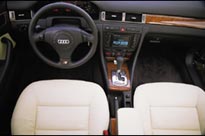 Leader's regime. What does this give in practice? Studies conducted by the Audi AG showed that the A6 C model 2.8 and the Multitronic transmission in dynamics significantly exceeds its analogue with Tiptronic: acceleration to a hundred is estimated at 8.1 seconds. Against 9.4. As for traditional mechanics, the gap is not so obvious here: 8.1 sec. Against 8.2. But in terms of efficiency in the mixed cycle, according to the manufacturer, the Audi A6 Multitronic wins with conservatives: 9.7 l/100 km versus 10.6 for Testronics and 9.9 in mechanics.
Leader's regime. What does this give in practice? Studies conducted by the Audi AG showed that the A6 C model 2.8 and the Multitronic transmission in dynamics significantly exceeds its analogue with Tiptronic: acceleration to a hundred is estimated at 8.1 seconds. Against 9.4. As for traditional mechanics, the gap is not so obvious here: 8.1 sec. Against 8.2. But in terms of efficiency in the mixed cycle, according to the manufacturer, the Audi A6 Multitronic wins with conservatives: 9.7 l/100 km versus 10.6 for Testronics and 9.9 in mechanics. Like the famous Tiptronic, the new transmission has automatic and manual control modes. Completely automatic provides smooth and dynamic, very comfortable acceleration. It seems that the car is equipped with an electric motor. If you follow the arrow of the tachometer at this time, you can see very unusual things. It is especially impressive when, with a sharp press on the gas pedal at a speed of about 70 km/h, the arrow of the tachometer and speedometer first move synchronously, and then when the first readings reach approximately 4500 rpm., The tachometer arrow returns back, while the speed continues to grow .
In automatic mode, the work of Multitronic resembles the operation of a modern machine with the difference that the machine reacts to gas more promptly and there are not even the slightest hints of shocks when switching gears. Only the maximum engine speeds in each gear do not exceed 5,000, apparently, in order to save fuel.
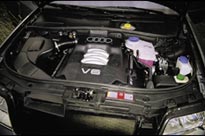 For more active drivers, a manual mode is provided, and the transition with automatic and vice versa is possible at any time of movement. If suddenly there is a need to accelerate very intensively or vice versa, inhibit the engine, it is enough to push the checkpoint selector to the right, and then switch the transmissions with a light movement of the hand forward or backward. In this mode, you can, by pressing the pedal into the floor, keep the engine at the maximum revolution (6500) until you reach the last sixth gear. Something reminds Tiptronic, with the difference that the speed increases avalanche and at the same time, the transition from transition from transmission to transmission does not show themselves in any way. If you are too lazy to push the selector to +, then when the maximum revolutions are reached, the system itself will switch to the transmission up this is exactly what we conventionally and called the third regime. You can also brake the engine, moving to one or several gears down. True, in the brains of the system, protection against a fool is provided, and switching down will not happen if the speed is too high.
For more active drivers, a manual mode is provided, and the transition with automatic and vice versa is possible at any time of movement. If suddenly there is a need to accelerate very intensively or vice versa, inhibit the engine, it is enough to push the checkpoint selector to the right, and then switch the transmissions with a light movement of the hand forward or backward. In this mode, you can, by pressing the pedal into the floor, keep the engine at the maximum revolution (6500) until you reach the last sixth gear. Something reminds Tiptronic, with the difference that the speed increases avalanche and at the same time, the transition from transition from transmission to transmission does not show themselves in any way. If you are too lazy to push the selector to +, then when the maximum revolutions are reached, the system itself will switch to the transmission up this is exactly what we conventionally and called the third regime. You can also brake the engine, moving to one or several gears down. True, in the brains of the system, protection against a fool is provided, and switching down will not happen if the speed is too high. 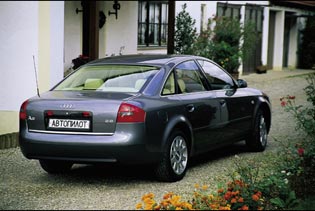 In general, Multitronic leaves the impression of the most desirable and successful compromise between traditional automatic and mechanics. Moreover, it provides wider possibilities than this or that system separately, although it is impossible to get rid of the feeling that there is no complete freedom of action, as in mechanics, it is limited by the control framework of the control unit.
In general, Multitronic leaves the impression of the most desirable and successful compromise between traditional automatic and mechanics. Moreover, it provides wider possibilities than this or that system separately, although it is impossible to get rid of the feeling that there is no complete freedom of action, as in mechanics, it is limited by the control framework of the control unit. Problem 2000. Is CVT able to supplant traditional mechanical and hydromechanical transmissions with fixed gear rates? Most likely, this is exactly what will happen, in any case, with traditional machine guns. Not tomorrow, of course, but you can already talk about the trend. Confirmation of this is the great activity in this direction and Japanese companies, it is enough to recall the Honda Civic and Nissan Primera of the 2000 year presented this year. The CVT also speaks in favor of the fact that in terms of reliability, the latest developments in this area, according to manufacturers, surpass all transmission options known to date. Well, the future will show, but for now, the new page is obvious in the automotive industry. And at least I now know how to answer the question: which is better, automatic or mechanic. CVT type Multitronic!
Text Andrey Timofeev, photo of the author and Audi
A source: "Autopilot"










